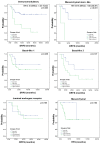Prognostic Capability of TNBC 3-Gene Score among Triple-Negative Breast Cancer Subtypes
- PMID: 36077821
- PMCID: PMC9454544
- DOI: 10.3390/cancers14174286
Prognostic Capability of TNBC 3-Gene Score among Triple-Negative Breast Cancer Subtypes
Abstract
Background: Triple-negative breast cancer (TNBC) is a complex and molecularly heterogeneous entity, with the poorest outcome compared with other breast cancer subtypes. Previously, we developed a TNBC 3-gene score with a significant prognostic capability. This study aims to test the 3-gene score in the different TNBC subtypes. Methods: Data from 204 TNBC patients treated with neoadjuvant chemotherapy were retrieved from public datasets and pooled (GSE25066, GSE58812, and GSE16446). After removing batch effects, cases were classified into Lehman’s TNBC subtypes and then the TNBC 3-gene score was used to evaluate the risk of distant recurrence in each subgroup. In addition, the association with tumor-infiltrating lymphocyte (TILs) levels was evaluated in a retrospective group of 72 TNBC cases. Results: The TNBC 3-gene score was able to discriminate patients with different risks within the pooled cohort (HR = 2.41 for high vs. low risk; 95%CI: 1.50−3.86). The score showed predictive capability in the immunomodulatory subtype (HR = 4.16; 95%CI: 1.63−10.60) and in the mesenchymal stem-like subtype (HR = 18.76; 95%CI: 1.68−208.97). In the basal-like 1, basal-like-2, and mesenchymal subtypes, the observed differential risk patterns showed no statistical significance. The score had poor predictive capability in the luminal androgen receptor subtype (p = 0.765). In addition, a low TNBC 3-gene score was related to a high level of TIL infiltration (p < 0.001). Conclusions: The TNBC 3-gene score is able to predict the risk of distant recurrence in TNBC patients, specifically in the immunomodulatory and mesenchymal stem-like subtype. Despite a small sample size in each subgroup, an improved prognostic capability was seen in TNBC subtypes with tumor-infiltrating components.
Keywords: DRFS; TNBC; prognostic biomarkers; survival.
Conflict of interest statement
The authors declare no conflict of interest.
Figures





References
-
- Bauer K.R., Brown M., Cress R.D., Parise C.A., Caggiano V. Descriptive Analysis of Estrogen Receptor (ER)-Negative, Progesterone Receptor (PR)-Negative, and HER2-Negative Invasive Breast Cancer, the so-Called Triple-Negative Phenotype. Cancer. 2007;109:1721–1728. doi: 10.1002/cncr.22618. - DOI - PubMed
-
- Vallejos C.S., Gómez H.L., Cruz W.R., Pinto J.A., Dyer R.R., Velarde R., Suazo J.F., Neciosup S.P., León M., de la Cruz M.A., et al. Breast Cancer Classification According to Immunohistochemistry Markers: Subtypes and Association With Clinicopathologic Variables in a Peruvian Hospital Database. Clin. Breast Cancer. 2010;10:294–300. doi: 10.3816/CBC.2010.n.038. - DOI - PubMed
LinkOut - more resources
Full Text Sources

